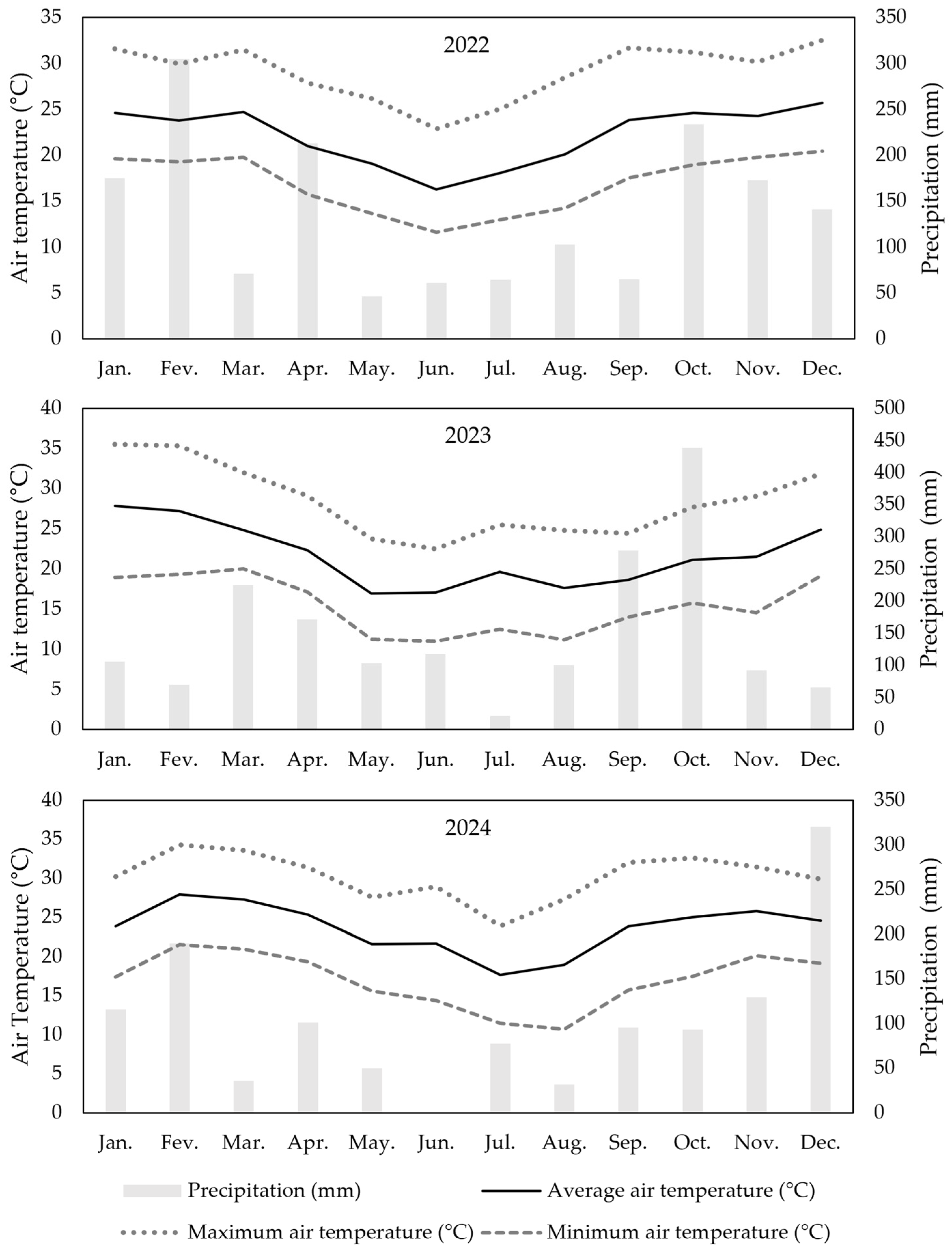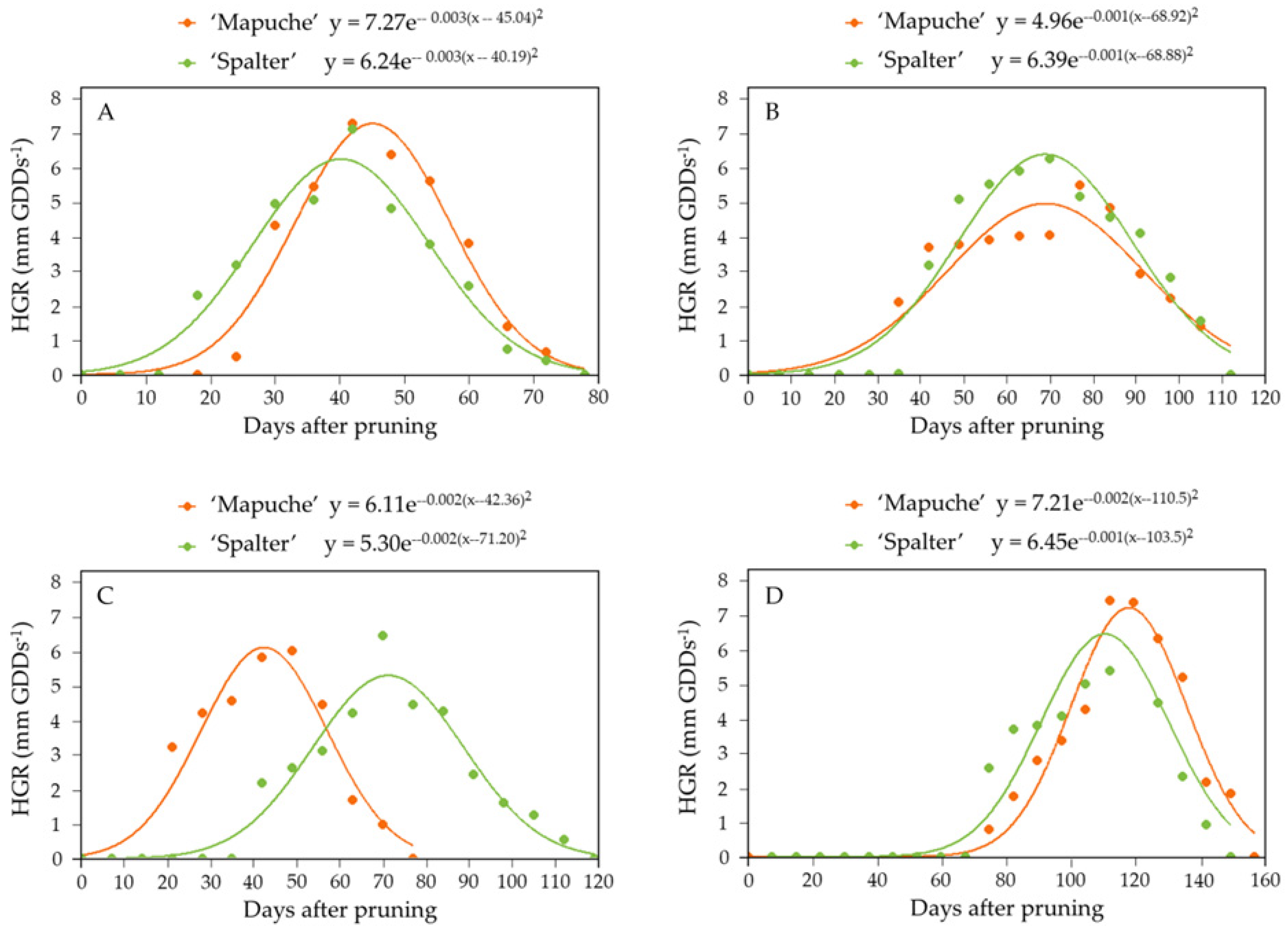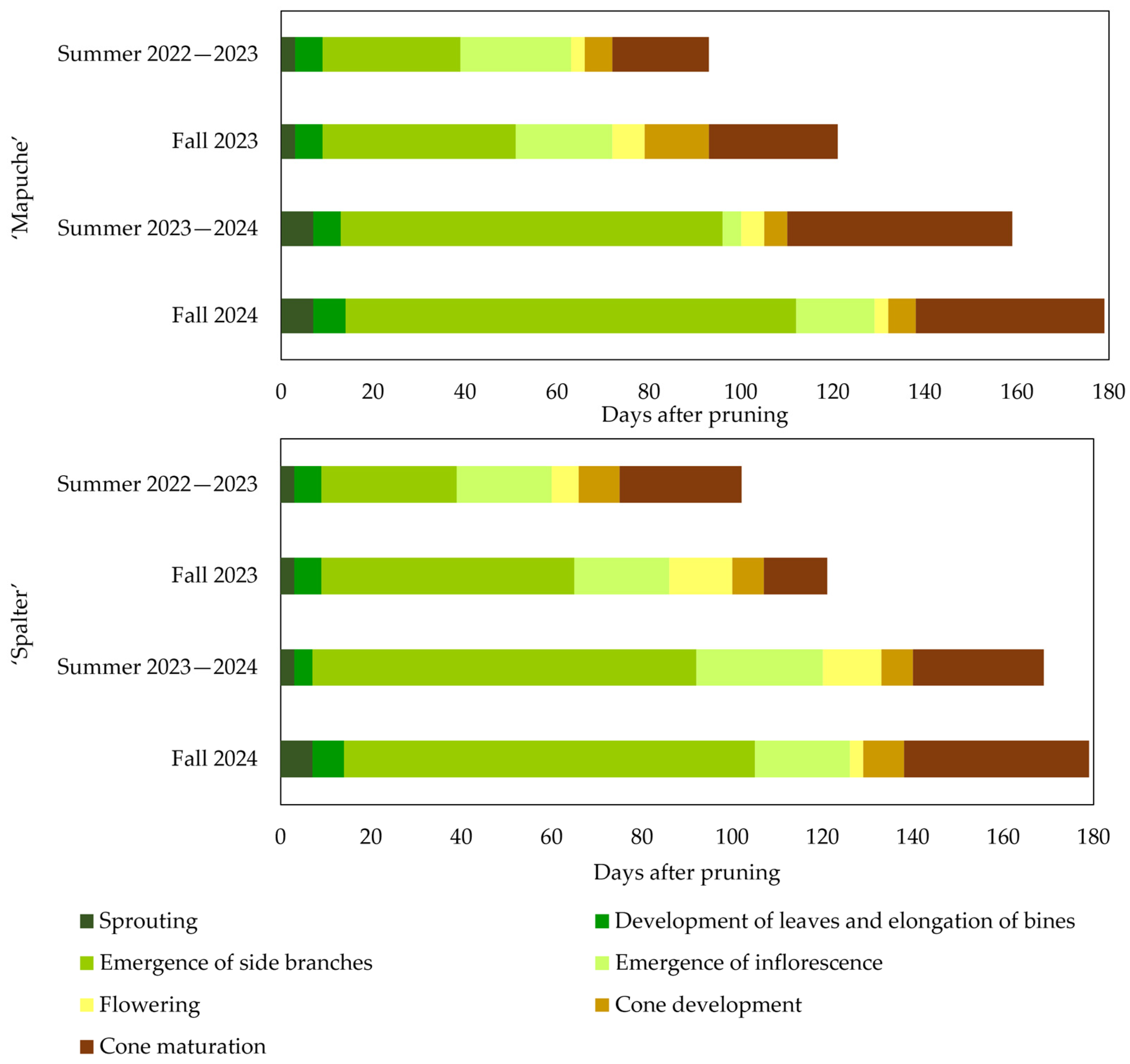Analysis of the Vegetative Growth Development and Phenology of Hop Cultivars Grown in the Subtropics Under a Two-Crop-a-Year System
Abstract
1. Introduction
2. Materials and Methods
2.1. Description of the Experimental Area and Experiment
2.2. Analysis
2.2.1. Vegetative Growth
2.2.2. Phenology
2.2.3. Statistical Analysis
3. Results
3.1. Vegetative Growth Development
3.2. Phenology
4. Discussion
4.1. Vegetative Growth
4.2. Phenology
5. Conclusions
Supplementary Materials
Author Contributions
Funding
Data Availability Statement
Acknowledgments
Conflicts of Interest
References
- Campos, O.P.; Fortuna, G.C.; Gomes, J.A.O.; Neves, C.S.; Bonfim, F.P.G. Morphological characteristics, trichomes, and phytochemistry of inflorescences of ‘Humulus lupulus’ L: Comparison of cropping systems and varieties. Aust. J. Crop Sci. 2023, 17, 263–274. [Google Scholar] [CrossRef]
- Jastrombek, J.M.; Faguerazzi, M.M.; De Cássio Pierezan, H.; Rufato, L.; Sato, A.J.; Da Silva Ricce, W.; Marques, V.V.; Leles, N.R.; Roberto, S.R. Hop: An Emerging Crop in Subtropical Areas in Brazil. Horticulturae 2022, 8, 393. [Google Scholar] [CrossRef]
- Ruggeri, R.; Rossini, F.; Roberto, S.R.; Sato, A.J.; Loussert, P.; Rutto, L.K.; Agehara, S. Development of hop cultivation in new growing areas: The state of the art and the way forward. Eur. J. Agron. 2024, 161, 127335. [Google Scholar] [CrossRef]
- Gutiérrez, R.M.; Oliveira, R.R.; Ribeiro, T.H.C.; Oliveira, K.K.P.; Silva, J.V.N.; Alves, T.C.; Amaral, L.R.; Gomes, M.S.; Gomes, M.S.; Chalfun-Júnior, A. Unveiling the phenology and associated floral regulatory pathways of Humulus lupulus L. in subtropical conditions. Planta 2024, 259, 150. [Google Scholar] [CrossRef]
- Acosta-Rangel, A.; Rechcigl, J.; Bollin, S.; Deng, Z.; Agehara, S. Hop (Humulus lupulus L.) phenology, growth, and yield under subtropical climatic conditions: Effects of cultivars and crop management. Aust. J. Crop Sci 2021, 15, 764–772. [Google Scholar] [CrossRef]
- Rossini, F.; Virga, G.; Loreti, P.; Iacuzzi, N.; Ruggeri, R.; Provenzano, M.E. Hops (Humulus lupulus L.) as a Novel Multipurpose Crop for the Mediterranean Region of Europe: Challenges and Opportunities of Their Cultivation. Agriculture 2021, 11, 484. [Google Scholar] [CrossRef]
- Marceddu, R.; Carrubba, A.; Sarno, M. Cultivation trials of hop (Humulus lupulus L.) in semiarid environments. Heliyon 2020, 6, e05114. [Google Scholar] [CrossRef]
- Muller, C.V.; Marcusso, E.F. Mapa Informa: As Cervejarias Continuam a Crescer; Divisão de Inspeção de Produtos de Origem Vegetal: Brasília, Brazil, 2018.
- Agehara, S. Using Supplemental Lighting to Control Flowering of Hops in Florida. EDIS 2020. 4p. Available online: https://edis.ifas.ufl.edu/publication/HS1365 (accessed on 27 March 2025). [CrossRef]
- Leles, N.R.; Sato, A.J.; Rufato, L.; Jastrombek, J.M.; Marques, V.V.; Missio, R.F.; Fernandes, N.L.M.; Roberto, S.R. Performance of Hop Cultivars Grown with Artificial Lighting under Subtropical Conditions. Plants 2023, 12, 1971. [Google Scholar] [CrossRef]
- Acosta-Rangel, A.; Agehara, S.; Rechcigl, J. Double-season production of hops (Humulus lupulus L.) with photoperiod manipulation in a subtropical climate. Sci. Hortic. 2024, 332, 113177. [Google Scholar] [CrossRef]
- Leles, N.R.; Sato, A.J.; Moreno, G.; Araldi, L.B.; Almeida, A.L.D.; Carli, V.W.; Roberto, S.R. Performance of hop cultivars (Humulus lupulus L.) under the annual double harvest system under artificial light supplementation in a subtropical climate. Semin., Ciênc. Agrár. 2024, 45, 1833–1850. [Google Scholar] [CrossRef]
- Varejão-Silva, M.A. Meteorologia e Climatologia, Versão Digital 2; INMET: Recife, Brazil, 2006.
- INMET—Instituto Nacional de Meteorologia. Available online: https://tempo.inmet.gov.br/tabela/mapa/S824/2024-08-19 (accessed on 27 March 2025).
- Agehara, S.; Carrubba, A.; Sarno, M.; Marceddu, R. Phenological Assessment of Hops (Humulus lupulus L.) Grown in Semi-Arid and Subtropical Climates Through BBCH Scale and a Thermal-Based Growth Model. Agronomy 2024, 14, 3045. [Google Scholar] [CrossRef]
- Carrubba, A.; Marceddu, R.; Sarno, M. Hop (Humulus lupulus L.): Suitability of traditional cultivars to a low-trellis farming system in a semiarid environment. HortScience 2022, 57, 1409–1415. [Google Scholar] [CrossRef]
- Robbauer, V.G.; Buhr, L.; Hack, H.; Hauptmann, S.; Klose, R.; Meier, U.; Staub, R.; Weber, E. Phanologische Entwicklungsstadien von Kultur-Hopfen (Humulus lupulus L.). Nachr. Dtsch. Pflanzenschutzd. 1995, 47, 249–253. [Google Scholar]
- Rossini, F.; Loreti, P.; Provenzano, M.E.; Santis, D.; Ruggeri, R. Agronomic performance and beer quality assessment of twenty hop cultivars grown in Central Italy. Ital. J. Agron. 2016, 11, 180–187. [Google Scholar] [CrossRef]
- Kluge, R.A.; Tezotto-Uliana, J.V.; Silva, P.P.M. Aspectos fisiológicos e ambientais da fotossíntese. Rev. Virtual Quím. 2015, 7, 56–73. [Google Scholar] [CrossRef]
- Eriksen, R.L.; Rutto, L.K.; DombrowskI, J.E.; Henning, J.A. Photosynthetic Activity of Six Hop (Humulus lupulus L.) Cultivars under Different Temperature Treatments. Hortscience 2020, 55, 403–409. [Google Scholar] [CrossRef]
- Bauerle, W.L. Disentangling photoperiod from hop vernalization and dormancy for global production and speed breeding. Sci. Rep. 2019, 9, 16003. [Google Scholar] [CrossRef]
- Sirrine, J.R.; Rothwell, N.; Goldy, R.; Marquie, S.; Brown-Rytlewski, D.E.; Lizotte, E. Sustainable Hop Production in the Great Lakes Region; Michigan State University Extension: East Lansing, MI, USA, 2010; Available online: https://www.uvm.edu/sites/default/files/media/Sirrine-Sustainable-Hop-Production-in-the-Great-Lakes-Region.pdf (accessed on 25 April 2025).
- Spósito, M.B.; Ismael, R.V.; Barbosa, C.M.A.; Tagliaferro, A.L. A Cultura do Lúpulo; ESALQ Divisão de Biblioteca: Piracicaba, Brazil, 2019. [Google Scholar]
- Nascimento, W.M.; Pereira, R.B. Produção de Mudas de Hortaliças; EMBRAPA Hortaliças: Brasília, Brazil, 2016. [Google Scholar]
- Donner, P.; Pokorný, J.; Ježek, J.; Krofta, K.; Patzak, J.; Pulkrábek, J. Influence of weather conditions, irrigation and plant age on yield and alpha-acids content of Czech hop (Humulus lupulus L.) cultivars. Plant Soil Environ. 2020, 66, 41–46. [Google Scholar] [CrossRef]
- Fagherazzi, M.M. Adaptabilidade de Cultivares de Lúpulo na Região do Planalto Sul Catarinense. Ph.D. Thesis, Universidade Estadual de Santa Catarina, Lages, Brazil, 2020. [Google Scholar]
- Mcadam, E.L.; Vaillancourt, R.E.; Koutoulis, A.; Whittock, S.P. Quantitative genetic parameters for yield, plant growth and cone chemical traits in hop (Humulus lupulus L.). BMC Genet. 2014, 15, 22. [Google Scholar] [CrossRef]
- De Wit, M.; Galvao, V.C.; Fankhauser, C. Light-mediated hormonal regulation of plant growth and development. Annu. Rev. Plant Biol. 2016, 67, 513–537. [Google Scholar] [CrossRef] [PubMed]
- Lastdrager, J.; Hanson, J.; Smeekens, S. Sugar signals and the control of plant growth and development. J. Exp. Bot. 2014, 65, 799–807. [Google Scholar] [CrossRef] [PubMed]
- Skomra, U.; Bocianowski, J.; Agacka, M. Agro-morphological differentiation between European hop (Humulus lupulus L.) cultivars in relation to their origin. J. Food Agric. Environ. 2013, 11, 1123–1128. [Google Scholar]
- Ruggeri, R.; Loreti, P.; Rossini, F. Exploring the potential of hop as a dual-purpose crop in the Mediterranean environment: Shoot and cone yield from nine commercial cultivars. Eur. J. Agron. 2018, 93, 11–17. [Google Scholar] [CrossRef]
- Lizotte, E.; Sirrine, R. Michigan Hop Management Guide 2020; Michigan State University Extension: East Lansing, MI, USA, 2020. [Google Scholar]




| Harvest Seasons | Cultivars | |||
|---|---|---|---|---|
| ‘Mapuche’ | ‘Spalter’ | |||
| Growth Duration (Days) | GDA (°C) | Growth Duration (Days) | GDA (°C) | |
| Summer 2022–2023 | 78 | 1840.6 | 78 | 1840.6 |
| Fall 2023 | 112 | 2083.9 | 112 | 2083.9 |
| Summer 2023–2024 | 77 | 1910.5 | 119 | 2856.0 |
| Fall 2024 | 147 | 3036.4 | 140 | 2798.5 |
| Seasons | Growth Stages 1 | HGR Values Range (mm GDDs−1) | Stages Duration in Days |
|---|---|---|---|
| ‘Mapuche’ | |||
| Summer 2022–2023 | I | 0.00–0.51 | 24 |
| II | 4.33–7.27 | 18 | |
| III | 6.38–3.80 | 18 | |
| IV | 1.40–0.00 | 18 | |
| Fall 2023 | I | 0.00–2.11 | 35 |
| II | 3.68–5.48 | 42 | |
| III | 4.83–2.22 | 21 | |
| IV | 1.39–0.00 | 14 | |
| Summer 2023–2024 | I | 0.00–2.99 | 21 |
| II | 4.20–6.01 | 28 | |
| III | 4.44–1.70 | 14 | |
| IV | 0.97–0.00 | 14 | |
| Fall 2024 | I | 0.00–2.79 | 84 |
| II | 3.37–7.40 | 21 | |
| III | 7.35–5.21 | 21 | |
| IV | 2.17–0.00 | 21 | |
| ‘Spalter’ | |||
| Summer 2022–2023 | I | 0.00–2.30 | 18 |
| II | 3.17–7.11 | 24 | |
| III | 4.81–2.56 | 18 | |
| IV | 0.73–0.00 | 18 | |
| Fall 2023 | I | 0.00–0.03 | 35 |
| II | 3.17–6.25 | 35 | |
| III | 5.18–2.82 | 28 | |
| IV | 1.56–0.00 | 14 | |
| Summer 2023–2024 | I | 0.00–2.62 | 49 |
| II | 3.11–6.45 | 21 | |
| III | 4.45–2.42 | 21 | |
| IV | 1.62–0.00 | 28 | |
| Fall 2024 | I | 0.00–2.57 | 70 |
| II | 3.68–9.23 | 42 | |
| III | 4.46–2.31 | 14 | |
| IV | 0.93–0.00 | 14 | |
Disclaimer/Publisher’s Note: The statements, opinions and data contained in all publications are solely those of the individual author(s) and contributor(s) and not of MDPI and/or the editor(s). MDPI and/or the editor(s) disclaim responsibility for any injury to people or property resulting from any ideas, methods, instructions or products referred to in the content. |
© 2025 by the authors. Licensee MDPI, Basel, Switzerland. This article is an open access article distributed under the terms and conditions of the Creative Commons Attribution (CC BY) license (https://creativecommons.org/licenses/by/4.0/).
Share and Cite
Leles, N.R.; Sato, A.J.; Missio, R.F.; Araldi, L.B.; de Aguiar, A.C.; Roberto, S.R. Analysis of the Vegetative Growth Development and Phenology of Hop Cultivars Grown in the Subtropics Under a Two-Crop-a-Year System. Horticulturae 2025, 11, 498. https://doi.org/10.3390/horticulturae11050498
Leles NR, Sato AJ, Missio RF, Araldi LB, de Aguiar AC, Roberto SR. Analysis of the Vegetative Growth Development and Phenology of Hop Cultivars Grown in the Subtropics Under a Two-Crop-a-Year System. Horticulturae. 2025; 11(5):498. https://doi.org/10.3390/horticulturae11050498
Chicago/Turabian StyleLeles, Nathalia Rodrigues, Alessandro Jefferson Sato, Robson Fernando Missio, Laura Baiocco Araldi, Aline Cristina de Aguiar, and Sergio Ruffo Roberto. 2025. "Analysis of the Vegetative Growth Development and Phenology of Hop Cultivars Grown in the Subtropics Under a Two-Crop-a-Year System" Horticulturae 11, no. 5: 498. https://doi.org/10.3390/horticulturae11050498
APA StyleLeles, N. R., Sato, A. J., Missio, R. F., Araldi, L. B., de Aguiar, A. C., & Roberto, S. R. (2025). Analysis of the Vegetative Growth Development and Phenology of Hop Cultivars Grown in the Subtropics Under a Two-Crop-a-Year System. Horticulturae, 11(5), 498. https://doi.org/10.3390/horticulturae11050498










